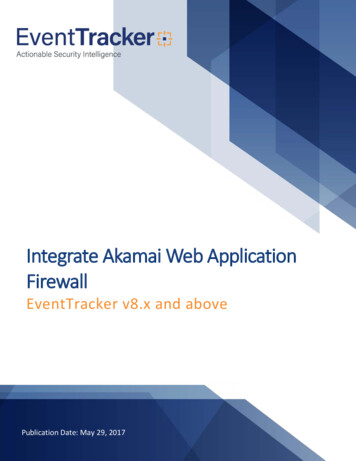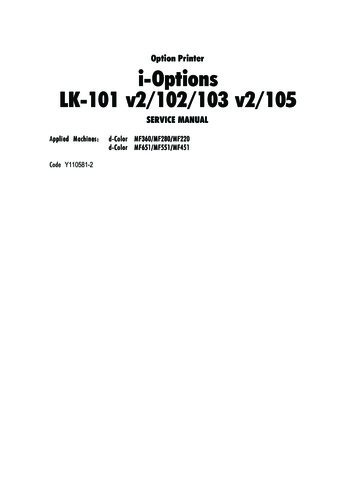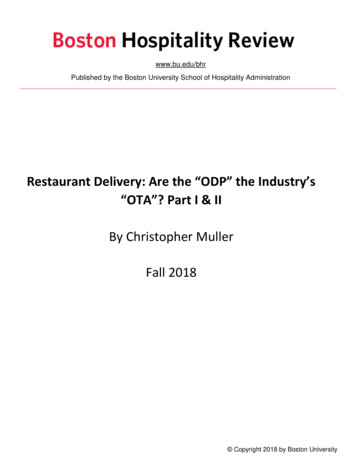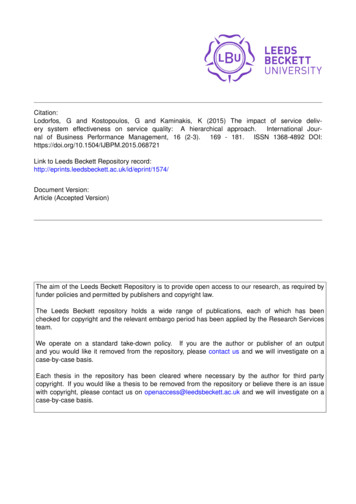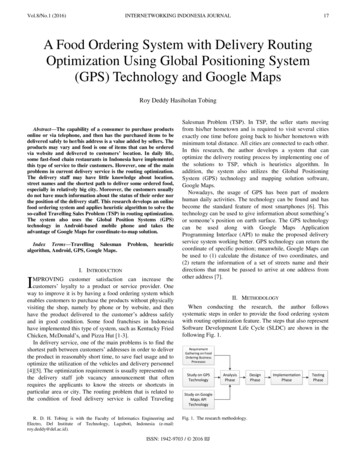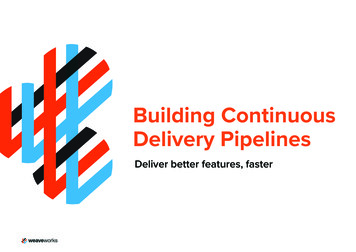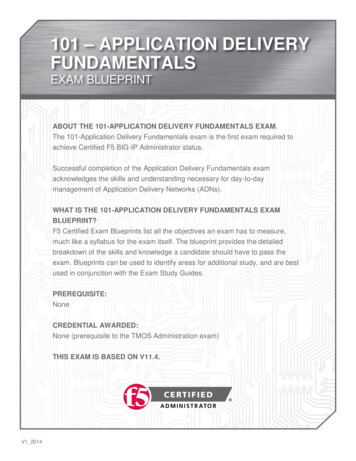
Transcription
101 – APPLICATION DELIVERYFUNDAMENTALSEXAM BLUEPRINTABOUT THE 101-APPLICATION DELIVERY FUNDAMENTALS EXAM.The 101-Application Delivery Fundamentals exam is the first exam required toachieve Certified F5 BIG-IP Administrator status.Successful completion of the Application Delivery Fundamentals examacknowledges the skills and understanding necessary for day-to-daymanagement of Application Delivery Networks (ADNs).WHAT IS THE 101-APPLICATION DELIVERY FUNDAMENTALS EXAMBLUEPRINT?F5 Certified Exam Blueprints list all the objectives an exam has to measure,much like a syllabus for the exam itself. The blueprint provides the detailedbreakdown of the skills and knowledge a candidate should have to pass theexam. Blueprints can be used to identify areas for additional study, and are bestused in conjunction with the Exam Study Guides.PREREQUISITE:NoneCREDENTIAL AWARDED:None (prerequisite to the TMOS Administration exam)THIS EXAM IS BASED ON V11.4.V1 2014
101 – APPLICATION DELIVERYFUNDAMENTALSEXAM BLUEPRINT201 - TMOS TECHNOLOGY xityObjective 1.01Explain, compare, and contrast the OSI layersExamplesDescribe the function of each OSI layerDifferentiate between the OSI layersDescribe the purpose of the various address types at different OSI layersObjective 1.02Explain protocols and technologies specific to the data link layerExamplesExplain the purpose of a switch’s forwarding databaseExplain the purpose and functionality of ARPExplain the purpose and functionality of MAC addressesExplain the purpose and functionality of a broadcast domainExplain the purpose and functionality of VLANsExplain the purpose and functionality of link aggregationObjective 1.03Explain protocols and apply technologies specific to the network layerExamplesExplain the purpose and functionality of IP addressing and subnettingGiven an IP address and net mask, determine the network IP and the broadcast IPGiven a routing table and a destination IP address, identify which routing table entry the destination IPaddress will matchExplain the purpose and functionality of Routing protocolsExplain the purpose of fragmentationGiven a fragment, identify what information is needed for reassemblyExplain the purpose of TTL functionalityGiven a packet traversing a topology, document the source/destination IP address/MAC address changes ateach hopObjective 1.04ExamplesObjective 1.05Explain the features and functionality of protocols and technologies specific tothe transport layerU/AU/AU/AU/ACompare/Contrast purpose and functionality of MTU and MSSExplain the purpose and functionality of TCPExplain the purpose and functionality of UDPExplain the purpose and functionality of ports in generalExplain how retransmissions occurExplain the purpose and process of a resetDescribe various TCP optionsDescribe a TCP checksum errorDescribe how TCP addresses error correctionDescribe how the flow control process occursExplain the features and functionality of protocols and technologies specific tothe application layerCognitive Complexity Key:R RememberA/E Analyze/EvaluateU/A Understand/ApplyU/A101 – Application Delivery Fundamentals exam blueprint Based on v11.4 2
101 – APPLICATION DELIVERYFUNDAMENTALSEXAM BLUEPRINTExamplesExplain the purpose and functionality of HTTPDifferentiate between HTTP versionsInterpret HTTP status codesDetermine an HTTP request method for a given use caseExplain the purpose and functionality of HTTP keepalives, HTTP headers, DNS, SIP, FTPDifferentiate between passive and active FTPExplain the purpose and functionality of SMTPExplain the purpose and functionality of a cookieGiven a situation in which a client connects to a remote host, explain how the name resolution process occursExplain the purpose and functionality of a URLCognitiveComplexitySection 2:F5 Solutions and TechnologyObjective 2.01Articulate the role of F5 productsExamplesExplain the purpose, use, and benefits of APM, LTM, ASM, GTMObjective 2.02Explain the purpose, use, and advantages of iRulesExamplesExplain the purpose of iRulesExplain the advantages of iRulesGiven a list of situations, determine which would be appropriate for the use of iRulesObjective 2.03Explain the purpose, use, and advantages of iAppsExamplesExplain the purpose of iAppsExplain the advantages of iAppsGiven a list of situations, determine which would be appropriate for the use of iAppsObjective 2.04U/AExplain the purpose of and use cases for full proxy and packetforwarding/packet based architecturesExamplesDescribe a full proxy architectureDescribe a packet forwarding/packet based architectureGiven a list of situations, determine which is appropriate for a full proxy architectureGiven a list of situations, determine which is appropriate for a packet based architectureObjective 2.05Explain the advantages and configurations of high availability (HA)ExamplesExplain active/activeExplain active/standbyExplain the benefits of deploying BIG-IP devices in a redundant configurationCognitive Complexity Key:R RememberA/E Analyze/EvaluateU/A Understand/ApplyU/AU/AU/AU/A101 – Application Delivery Fundamentals exam blueprintBased on v 11.4 3
101 – APPLICATION DELIVERYFUNDAMENTALSEXAM BLUEPRINTCognitiveComplexitySection 3:Load Balancing EssentialsObjective 3.01Discuss the purpose of, use cases for, and key considerations related to loadbalancingU/AExamplesExplain the purpose of distribution of load across multiple serversGiven an environment, determine the appropriate load balancing algorithm that achieves a desired resultExplain the concept of persistenceObjective 3.02Differentiate between a client and serverExamplesGiven a scenario, identify the client/serverExplain the role of a clientExplain the role of a serverSection 4:SecurityObjective 4.01Compare and contrast positive and negative security modelsExamplesDescribe the concept of a positive security modelDescribe the concept of a negative security modelGiven a list of scenarios, identify which is a positive security modelGiven a list of scenarios, identify which is a negative security modelDescribe the benefits of a positive security modelDescribe the benefits of a negative security modelObjective 4.02Explain the purpose of cryptographic servicesExamplesDescribe the purpose of signingDescribe the purpose of encryptionDescribe the purpose of certificates and the certificate chainsDistinguish between private/public keysCompare and contrast symmetric/asymmetric encryptionObjective 4.03Describe the purpose and advantages of authenticationCognitive Complexity Key:R RememberA/E Analyze/EvaluateU/A Understand/ApplyU/ACognitiveComplexityU/AU/AU/A101 – Application Delivery Fundamentals exam blueprintBased on v 11.4 4
101 – APPLICATION DELIVERYFUNDAMENTALSEXAM BLUEPRINTExamplesExplain the purpose of authenticationExplain the advantages of single sign onExplain the concepts of multifactor authenticationDescribe the role authentication plays in AAAObjective 4.04Describe the purpose, advantages, and use cases of IPsec and SSL VPNExamplesExplain the purpose, advantages, and challenges associated with IPsecExplain the purpose, advantages, and challenges associated with SSL VPNGiven a list of environments/situations, determine which is appropriate for an IPsec solutionGiven a list of environments/situations, determine which is appropriate for an SSL VPN solutionSection 5:Application Delivery PlatformsObjective 5.01Describe the purpose, advantages, use cases, and challenges associatedwith hardware based application delivery platforms and virtual machinesExamplesObjective 5.02ExamplesU/ACognitiveComplexityU/AExplain when a hardware based application deliver platform solution is appropriateExplain when a virtual machine solution is appropriateExplain the purpose, advantages, and challenges associated with hardware based application deliver platformsolutionsExplain the purpose, advantages, and challenges associated with virtual machinesGiven a list of environments/situations, determine which is appropriate for a hardware based applicationdeliver platform solutionGiven a list of environments/situations, determine which is appropriate for a virtual machine solutionExplain the advantages of dedicated hardware (SSL card, compression card)Describe the purpose of the various types of advanced accelerationtechniquesU/ADescribe the purpose of TCP optimizationDescribe the purpose of HTTP keepalives, caching, compression, and pipeliningCognitive Complexity Key:R RememberA/E Analyze/EvaluateU/A Understand/Apply101 – Application Delivery Fundamentals exam blueprintBased on v 11.4 5
101 – APPLICATION DELIVERYFUNDAMENTALSEXAM BLUEPRINTEXAM DETAILSHow much do Certified exams cost? 135 USD (not including local taxes and fees).How long is the 101 exam and what is the passing score?The 101 exam is 90 minutes long and the passing score is 69%.How many questions are there?The 101 exam has 80 questions. Some of the questions contain exhibits that youwill have to view to answer the question.What format is the 101 exam?The 101 exam is multiple choice.What is the retake policy?1st failure: Exam hold for 15 days.2nd failure: Exam hold for 30 days.3rd failure: Retake permission form and a 45-day exam hold.4th failure: Exam hold for two (2) years.Exam day tips: Cognitive Complexity Key:R RememberA/E Analyze/EvaluateU/A Understand/ApplyMake sure the name on your Pearson VUE account matches the name onyour ID. To change your name and other personal information, see (insertURL).If you need to reschedule your exam, you must contact Pearson VUE 24hours before your exam time101 – Application Delivery Fundamentals exam blueprintBased on v 11.4 6
101 – APPLICATION DELIVERYFUNDAMENTALSEXAM BLUEPRINTCognitive Complexity DescriptionsLower Order Thinking SkillsHigher Order Thinking teInformationretrievalKnowledge transferCritical thinking andreasoningInnovation orCreative thinkingRotememorizationComprehension orAbility to applyknowledge to astandard processDetermine howparts relate towhole or Knowledgeintegration andapplication to newsituation(s)Forming an originalwork productRetrieve relevantknowledge fromlong-term memoryConstruct meaningfrom informationMake judgmentsbased on criteriaCombine or reorganizeparts to form a newpattern or structuree.g., recall, retrieve,recognizee.g., interpret, classify,compare, explain,implemente.g., troubleshoot,attribute, diagnose,critiquee.g., generate, plan,produceAlpine Testing Solutions’ suggested cognitive complexity levels and associated verb references consider multipleapproaches to defining cognitive processing (e.g., Anderson et al., Webb, Bloom, Frisbie). Above material created withassistance from Alpine and distributed with Alpine’s permission as an attachment to certification test blueprints.Alpine Testing Solutions, Inc. (Alpine) gives F5 Networks permission to distribute the PDF “Cognitive Complexity Description 20130418.pdf” as an attachmentto certification test blueprints created with assistance from Alpine into the exam blueprint. 2014 F5 Networks, Inc. All rights reserved. F5, F5 Networks, and the F5 logo are trademarks of F5 Networks, Inc. in the U.S. and in certain other countries.Other F5 trademarks are identified at f5.com. Any other products, services, or company names referenced herein may be trademarks of their respectiveowners with no endorsement or affiliation, express or implied, claimed by F5.101 – Application Delivery Fundamentals exam blueprintBased on v 11.4 7
The 101-Application Delivery Fundamentals exam is the first exam required to . Security Cognitive Complexity . Alpine Testing Solutions, Inc. (Alpine) gives F5 Networks permission to distribute the PDF “Cognitive Complexity De



